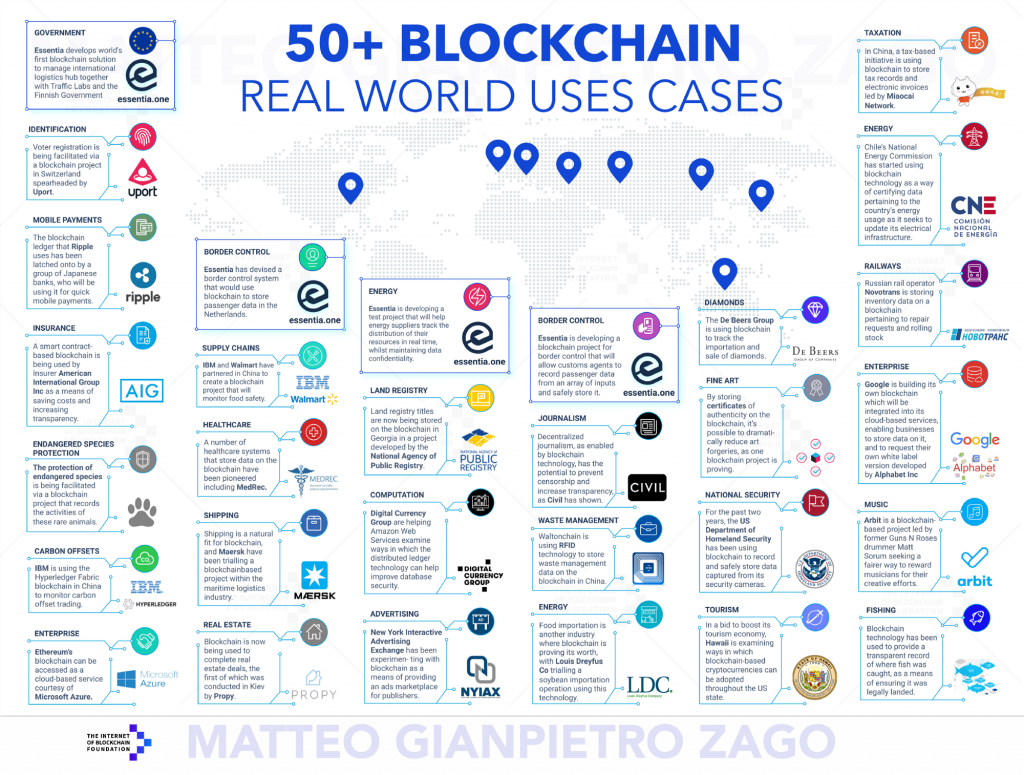
How the Consortium Blockchain Works
September 25, 2019
Corda and Real Businesses Built on Top of This Framework
August 23, 2019
In practice, blockchain technology is a playground for firm transactions between the actors who meet in the digital environment. Specifically, it’s based on the pieces of information recorded by individual users – or the chain of blocks. Because of that, the community can manage blockchain technologies, possessing an ability to improve and update these blocks. In this context, the essential element of blockchain technology is the net of nodes, or computers, that have access to the spreadsheets (or blocks) with records and an ability to verify their validity.
As another way to provide blockchain technology definition, it can be described as Wikipedia of transactions. In fact, blockchain technologies are frequently compared to this Web space because they work on the similar basis – being controlled by the overall community, not by a limited amount of chosen individuals. In this context, a person reads the ‘master copy’ on Wikipedia of the page of his/her interest, which is updated manually by users who write articles there. The same situation applies to the blockchain technology, but with a crucial vary – there is no administration to decide the ‘master copy’ status. And so, even the Wikipedia-like level of distributed centralization doesn’t apply to blockchain technologies – all the nodes in great request become ‘master copies’ automatically.
To comprehend the basis of the operation of blockchain technologies, it’s relevant to refer to three underlying innovations that enabled its appearance.
For blockchain technology, private key cryptography is the basis for the proper authentication, among all. In fact, it enables its operation by using a unique code that is sufficient for participating – there’s no need for revealing the sensitive personal data. Hence, this technology significantly contributes to the high level of safety for blockchain.
Furthermore, P2P network enables interpersonal transactions. So, blockchain technologies exclude third parties from the trading operations. In other words, the peer-to-peer network covers the authorization requirements of the blockchain transactions.
Finally, the protocol appearance has put blockchain technology’s idea into action. Specifically, it guarantees its existence as we know it – with the specific rules, mining, hash, and other regulations.
Therefore, any definition of blockchain technology grounds on the authentication principle of private key cryptography and P2P network authorization. And these components work within the set rules guaranteed by a protocol.

In general, the perspectives of blockchain technology use cases are promising. Providing a simple and secure basis for monetary operations, the innovation can be easily incorporated into various spheres, including the banking sector, financial services and real estate. And the range of uses of blockchain technology is wide enough to include other spheres – like voting and healthcare.
Among the uses of blockchain technology, the appearance of smart contracts and supply chain are among the most important ones. In particular, smart contracts, working on the basis of Ethereum, incorporate a cryptographic code into the internal design of their intermediary-free operations. In its turn, supply chain uses to blockchain technology include all the stages of the common operations, including recording, tracking, assigning, linking, and sharing.
Among the main advantages of blockchain technology, it ensures a higher safety and freedom on market. Excluding the centralization to maximum, the platform is truly difficult to hack. Even if such an attempt takes place, the criminal can get a copy of a small element within the system only – so, basically, can’t do anything with it. Due to such a high safety guarantee, it’s possible to enjoy all the other benefits of blockchain technology to the fullest.
Also, one of the key benefits of blockchain technology is its accuracy. In other words, it provides the unprecedented level of control over the mistakes, meaning thousands of nodes involved in a transaction verification. Thus, there is a slight possibility of a human error involved in a trade.
Besides, the list of blockchain technology benefits commonly includes cost-effectiveness. Traditionally, most financial operations call for asking for bank verification and notary signature. Here, the avoidance of all the third parties enables to reduce the cost of these actions. As a result, the cost advantages of blockchain technology are striking.
The history of blockchain technology starts with the theoretical assumptions made by Stuart Haber and W. Scott Stornetta in 1991. Back then, the slight draft of the innovation as we know it appeared and developed for more than a decade in the works of other authors.

(Stuart Haber and W. Scott Stornetta)
As for the introduction of the term itself, its author was Nick Szabo and it happened in 1994. At that moment of the history of blockchain technology, the concept was detailed by the notions of smart contracts, compromise, agreement, and the absence of an intermediary.
To make theory work, the discovery of Bitcoin in 2009 was a turning point in blockchain technology history. Satoshi Nakamoto, its author, introduced the concepts of cryptocurrency and decentralization for the first time then. And still, it’s an essential of blockchain operations. However, Bitcoin and blockchain do not mean the same thing.
Precisely, the history of blockchain technology’s separation from Bitcoin started in 2014. That year, the observers realized that the platform can be used for more than just cryptocurrency operations. With the heavy investment, the innovation started to include more spheres.
And with this last key event in blockchain technology history, it turned into the playground of safe transactions as we know it now. So, the following overview of the most effective blockchain technology use cases proves that this shift was worth it.

Nowadays, there appeared numerous examples of blockchain technology worth mentioning and giving a try. Among the most popular ones, digital identity is a brand-new way to save the time commonly spent on a paperwork for verification. Within blockchain, a ready-to-use digital ID is the private key. In addition, industrial examples of blockchain technology revealed their effectiveness – like in energy market, where it helps in controlling energy consumption.
As the basic application of blockchain technology in healthcare, it improves the way medical data is recorded. To make it work, the record about the patient’s state should be incorporated into the blockchain – and in return, this person can be sure in its secure and untouched storage. By protecting the medical information, blockchain technology in healthcare makes it accessible to a strictly limited amount of individuals.

The perk of including blockchain technology in banking is the possibility to initiate transactions 24/7 and in the fastest way. Besides, the security principle, guaranteed by the innovation, can also significantly contribute to the safety of operations currently made. Finally, blockchain technology in banking mitigates numerous risks of cross-border big-sum transfers.
As for blockchain technology insurance, its achievements include the common benefits of increased protection, transparency and accountability of the operations. In this context, the informational basis of common operations in the industry receives the increased level of security by applying the uses of blockchain technology. Besides, fast and accurate big data management is another injection of blockchain technology insurance. Finally, proper calculations conclude the list of adjustments provided by the technology in the area.
For blockchain technology and real estate, the better tracking of property records works. In particular, the avoidance of centralized recording office is the basic perspective. In addition, the technology significantly facilitates the cases of disputes – with the avoidance of searching for the necessary documentation and further scanning it for the applicable information. Finally, the possibility for the human error is minimized here – with the enhanced level of automatization and accuracy. In this context, the unity of blockchain technology and real estate appears truly revolutionary.
Among all, blockchain technology for voting makes it possible to avoid the long queues and election fraud on the voting place. To make the innovation work, each vote can be turned into the block within a blockchain for further secure and transparent storing. In other words, blockchain technology for voting works as the reliable platform that enhances the regulation on election day and during the further calculation of votes.
In addition to the revolutionary appearance of smart contracts, blockchain technology financial services is a fast-developing area nowadays. In this case, the brand-new cryptocurrency and bitcoin operations have brought new opportunities and challenges in the area. Due to this, the areas of interest for blockchain technology financial services include simplification of international transactions, improvement in share trading, and automatization of basic financial operations. Besides, the discussions on the impact of blockchain technology use cases on online identity management and ensuring greater customer loyalty have also started in the sphere.
To comprehend blockchain technology architecture, it’s relevant to refer to the distinction between public and private blockchain. As for the public blockchain, the underlying elements of its operations include Bitcoin, cash, Monero, and Ethereum. Due to their specifics, this type of blockchain technology architecture is open for anybody to participate without waiting for an approval. In contrast, the permissioned blockchains are based on Hyperledger, Quorum, Chain, c-rda, Monax, and ripple. Their privacy is guaranteed by the invitation rule.
Notwithstanding the exact type, the data within blockchain is transferred through smart contracts and has the basis of a consensus mechanism of the highest safety.
Considering the great number of blockchain technology use cases, the innovation is doing good. Moreover, with many companies eager to invest in it, the future of blockchain technology seems bright. However, there exist some concerns.
Precisely, the basic predictions on blockchain technology future include its further standardization and automatization along with the possible absorption of its achievements by traditional frameworks. In these polar ideas, it’s still a big question whether the future of blockchain technology is promising – or there is no blockchain technology future at all.
In the end, the only thing that can be said for sure now is, ‘Will see’. And keep investing in it to remain optimistic.


